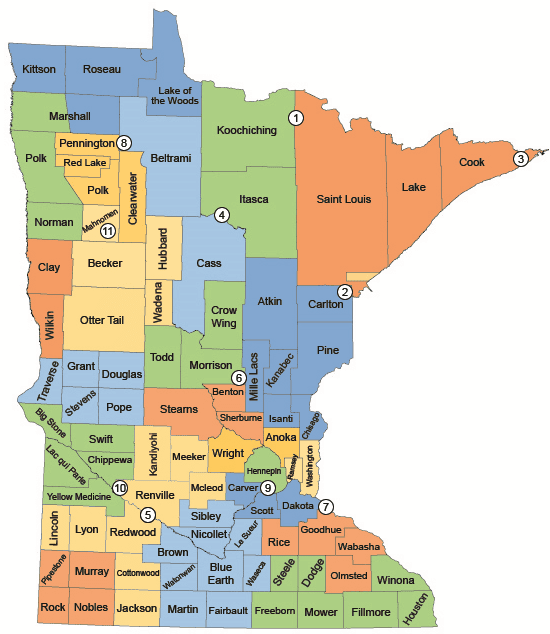
2 healthcare facilities remain able to accommodate those who require intensive medical intervention. This Executive Order is consistent with a growing nationwide effort to contain the spread of COVID-19. On March 16, 2020, President Donald Trump issued guidelines to limit gatherings of more than 10 people. As of March 24, 2020, twenty-four states representing almost 200 million Americans have issued orders or public health directives closing non-essential businesses or limiting residents from participating in non-essential activities. Limiting activities to only those which are most essential and practicing social distancing at all times are vital tools required to mitigate the community spread of COVID-19 in Minnesota and nationwide. On March 23, 2020, the U.S. Department of Homeland Security issued Guidance on the Essential Critical Infrastructure Workforce: Ensuring Community and National Resilience inCOVID-19 Response (“CISA Guidance”—attached to, and incorporated into, this Executive Order). The CISA Guidance identifies workers who conduct a range of operations and services that are essential to continued critical infrastructure viability. This federal guidance provides a baseline for Minnesota’s efforts to ensure critical infrastructure and services are maintainedwhile slowing the spread of COVID-19.In Minnesota Statutes 2019, section 12.02, the Minnesota Legislature conferred upon the Governor emergency powers “in order to (1) ensure that preparations of this state will be adequate to deal with disasters, (2) generally protect the public peace, health, and safety, and (3) preserve the lives and property of the people of the state.” Pursuant to Minnesota Statutes 2019, section 12.21, subdivision 1, the Governor has general authority to control the state’s emergency management as well as carry out the provisions of Minnesota’s Emergency Management Act. Minnesota Statutes 2019, section 12.21, subdivision 3(7), authorizes the Governor to cooperate with federal and state agencies in “matters pertaining to the emergency management of the state and nation . . . .” including “the direction or control of . . . the conduct of persons in the state, including entrance or exit from any stricken or threatened public place, occupancy of facilities, and . . . public meetings or gatherings . . . .” Pursuant to subdivision 3 of that same section, the Governor may “make, amend, and rescind the necessary orders and rules to carry out the provisions” of Minnesota Statutes 2019, Chapter 12. When approved by the Executive Council and filed in the Office of the Secretary of State, such orders and rules have the force and effect of law during the peacetime emergency. Any inconsistent rules or ordinances of any agency or political subdivision of the state are suspended during the pendency of the emergency. Any person who willfully violates such an order or rule is guilty of a misdemeanor and upon conviction must be punished by a fine not to exceed $1,000 or by imprisonment for not more than 90 days. For these reasons, I order as follows: 1.Beginning on Friday, March 27, 2020 at 11:59 pm through Friday, April 10, 2020 at 5:00 pm, all persons currently living within the State of Minnesota are ordered to stay at home or in their place of residence except to engage in the Activities and CriticalSector work set forth below in Paragraphs 5 and 6.
3 2.For purposes of this Executive Order, homes or residences include hotels, motels, shared rental units, shelters, and similar facilities, to the extent they are used for lodging. 3.This Executive Order does not restrict virtual work or telework (i.e . work from home), and Minnesotans working in any field are encouraged to work from their home or residence as much as possible.4.Definitions.As used in this Executive Order, “workers” and “personnel” are broadly defined to include employees, contractors, vendors, and volunteers. As used in this Executive Order, “Critical Sectors” is defined to include the categories found in the CISA Guidance and the additional categories listed below. 5.Exemptions – Activities. Minnesotans may leave their homes or residences to engage in the following activities, provided that all persons follow the guidelines set forth and maintained by the Minnesota Department of Health (“MDH Guidelines”), including but not limited to social distancing, to the maximum extent possible. This list of Activities may be clarified, as deemed necessary by the Governor, to ensure the health, safety, and security of all Minnesotans. Clarifications will be available for public review at: https://www.health.state.mn.us/diseases/coronavirus/a.Relocation to ensure safety. Individuals whose homes or residences are unsafe or become unsafe, including individuals who have suffered or are at risk of domestic violence or for whom the safety, sanitation or essential operations of the home or residence cannot be maintained, are allowed and urged to leave their home or residence and relocate to a safe alternative home or residence. b.Health and s afety activities. Individuals may seek emergency services, obtain medical services, supplies, and medications, and visit a health care or dental professional or facility, or a veterinarian. Individuals may also donate blood. c.Outdoor activities. Individuals may engage in outdoor activities (e.g.,walking, hiking, running, biking, driving for pleasure, hunting, or fishing), and may go to available public parks and other public recreation lands, consistent with remaining at least six feet apart from individuals from other households. This does not exempt public accommodations that may feature outdoor activities from closure under Executive Order 20-04 and does not permit trespass upon private property. d.Necessary supplies and services. Individuals may obtain food, including delivery or carry-out services, beverages (alcoholic and non-alcoholic), and other grocery items, gasoline, supplies needed to work from home, and products needed to maintain the safety, sanitation, and essential operation of homes and residences, businesses, and personally owned vehicles, including
